The Cambridge History of China. Vol. 12: Republican China, 1912-1949, Part 1
Подождите немного. Документ загружается.

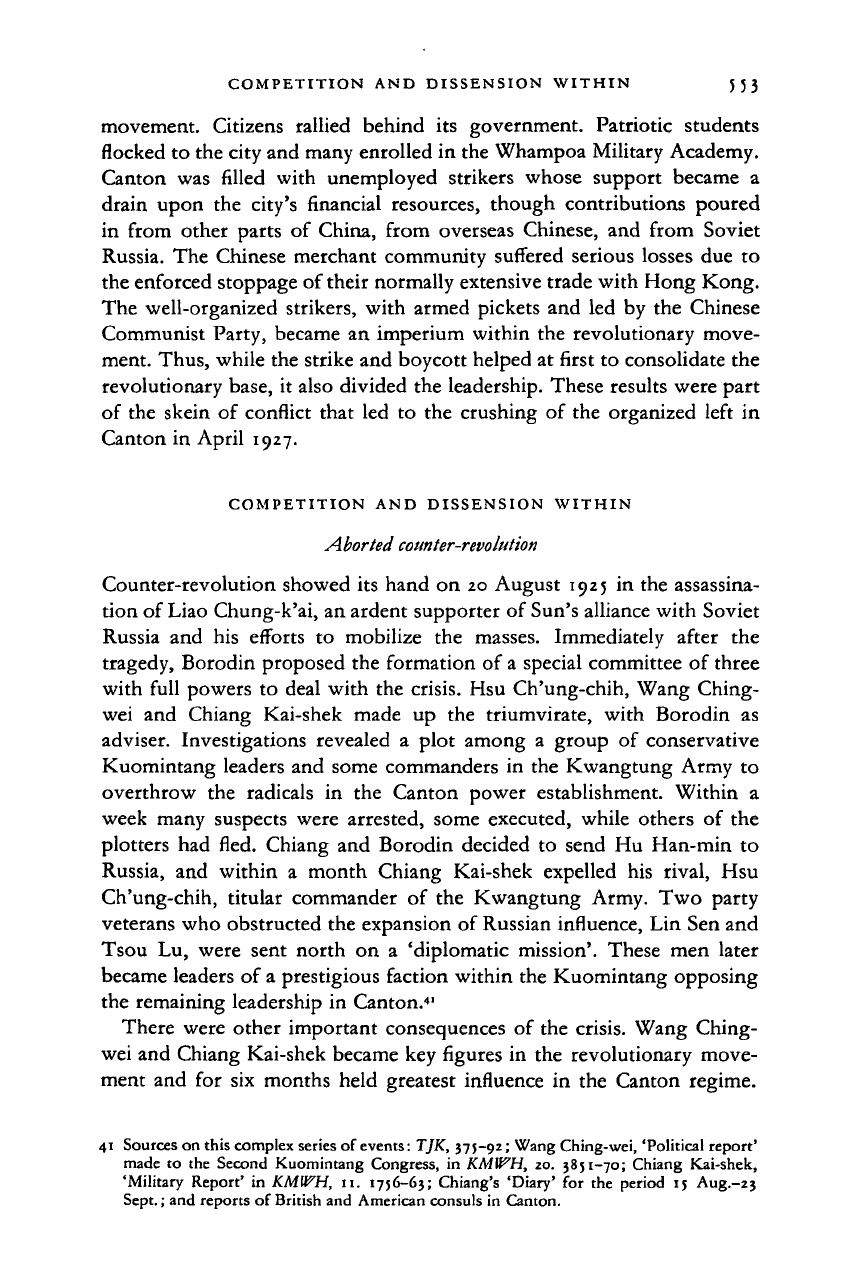
COMPETITION AND DISSENSION WITHIN 553
movement. Citizens rallied behind its government. Patriotic students
flocked to the city and many enrolled in the Whampoa Military Academy.
Canton was filled with unemployed strikers whose support became a
drain upon the city's financial resources, though contributions poured
in from other parts of China, from overseas Chinese, and from Soviet
Russia. The Chinese merchant community suffered serious losses due to
the enforced stoppage of their normally extensive trade with Hong Kong.
The well-organized strikers, with armed pickets and led by the Chinese
Communist Party, became an imperium within the revolutionary move-
ment. Thus, while the strike and boycott helped at first to consolidate the
revolutionary base, it also divided the leadership. These results were part
of the skein of conflict that led to the crushing of the organized left in
Canton in April 1927.
COMPETITION AND DISSENSION WITHIN
Aborted
counter-revolution
Counter-revolution showed its hand on 20 August 1925 in the assassina-
tion of Liao Chung-k'ai, an ardent supporter of Sun's alliance with Soviet
Russia and his efforts to mobilize the masses. Immediately after the
tragedy, Borodin proposed the formation of a special committee of three
with full powers to deal with the crisis. Hsu Ch'ung-chih, Wang Ching-
wei and Chiang Kai-shek made up the triumvirate, with Borodin as
adviser. Investigations revealed a plot among a group of conservative
Kuomintang leaders and some commanders in the Kwangtung Army to
overthrow the radicals in the Canton power establishment. Within a
week many suspects were arrested, some executed, while others of the
plotters had fled. Chiang and Borodin decided to send Hu Han-min to
Russia, and within a month Chiang Kai-shek expelled his rival, Hsu
Ch'ung-chih, titular commander of the Kwangtung Army. Two party
veterans who obstructed the expansion of Russian influence, Lin Sen and
Tsou Lu, were sent north on a 'diplomatic mission'. These men later
became leaders of a prestigious faction within the Kuomintang opposing
the remaining leadership in Canton.
41
There were other important consequences of the crisis. Wang Ching-
wei and Chiang Kai-shek became key figures in the revolutionary move-
ment and for six months held greatest influence in the Canton regime.
41 Sources on this complex series of
events:
TJK, 375-92; Wang Ching-wei, 'Political report'
made to the Second Kuomintang Congress, in
KtAWH,
20. 3851-70; Chiang Kai-shek,
'Military Report' in
KMWH,
11. 1756-63; Chiang's 'Diary' for the period 15 Aug.-Z3
Sept.; and reports of British and American consuls in Canton.
Cambridge Histories Online © Cambridge University Press, 2008
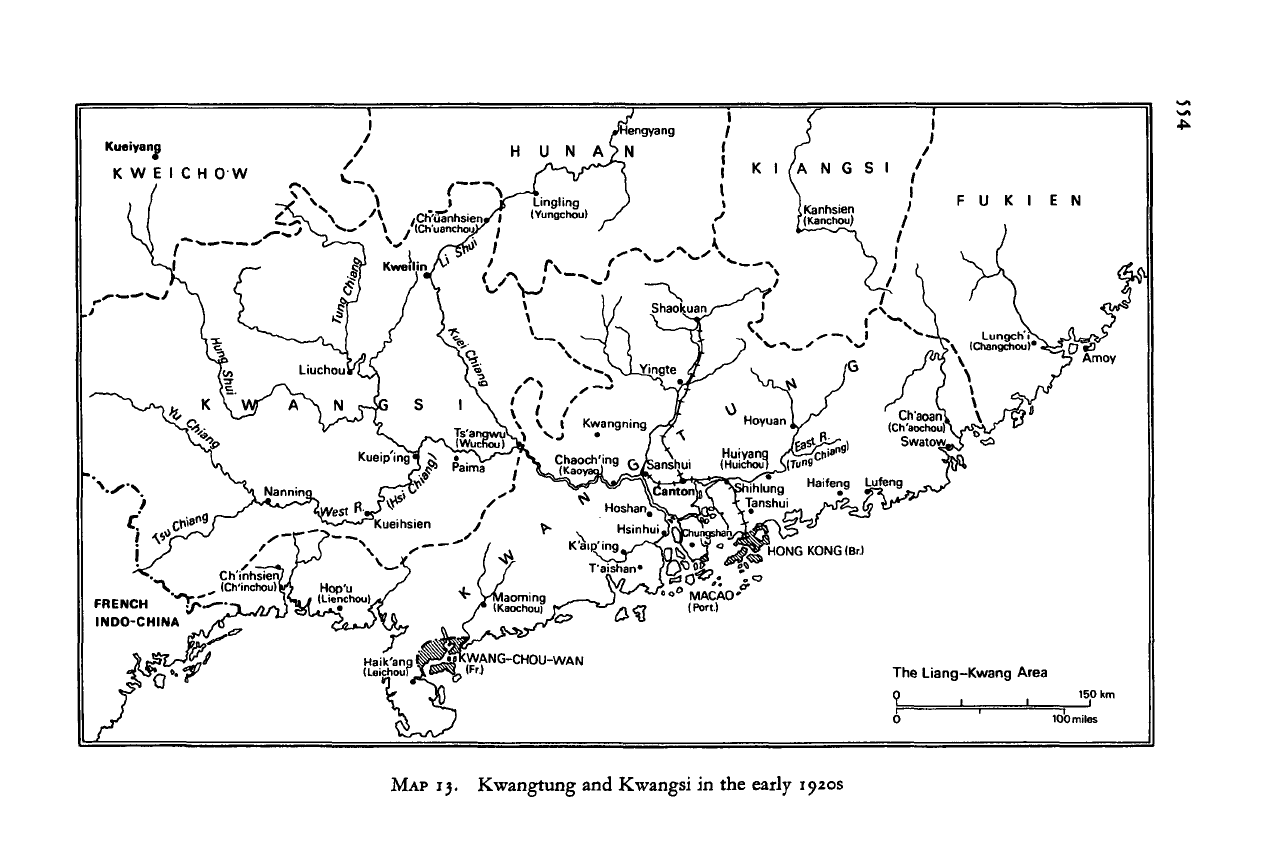
Kueiyang
K W E 1
u,
>
i /"
FRENCH '"
INDO-CHINA
/
C H
(
I
-A,
V-
r
0
W
4
<
N
N
r
y,
Nar
/
_
(Ch'inchou)j
>>
LiuchouV
A\ N
nina
f
i
1
/
~N
'
\ .
(Ch'ui
|*
Kweilin/
/
i
/
^
T
JG
S
Kueip'ing^
Jj
•^Kueihsien
*i
Hop-u y
Suj (LionchoulV
^T
4
KSSSPjft
In
^^.
L ji
Q
a
'A
i
(Wucffiu)
P3IITI3
/
i
(V
/*(K
H
/
/
\
i
lor
IOC
U
N
/^V
Lingling
(Yungcho
jRengyang
ASN
-y
.
™"^
/
\
\
\
\
i
X. Cha<
K'
^kWANG-CHOU-WA^
V
\
a<
Kwangning y-4
Hsinhuiali
Taishan*
/£
1
•
1
1
I
\
\
^
> \
jl«ian/-"^
I
0
Hui
tonVC ^p
jChungshan^;
\» Vtf o *
° MACAO*
(Port.)
K
1 [A N G S
(Kanhsien
f(Kanchou)
Hoyuan L/
yang ^tS^dwm
1
Kihtag
Haife
;s ^i
Tanshui
/TJKJ
|gHONG KONG(Br.l
1
1
1
f
1
/
,'
F U K 1
( 1
' ^
V\
C
N \
^"-^x
Lungch'N^
r
Chaoar\
\ /»»
(Ch'aochouAjA^T I-"
SwatowJX O
The Liang-Kwang Area
?_ i i
0
E N
^^j Amoy
150 km
100
miles
MAP
13. Kwangtung and Kwangsi in the early 1920s
Cambridge Histories Online © Cambridge University Press, 2008
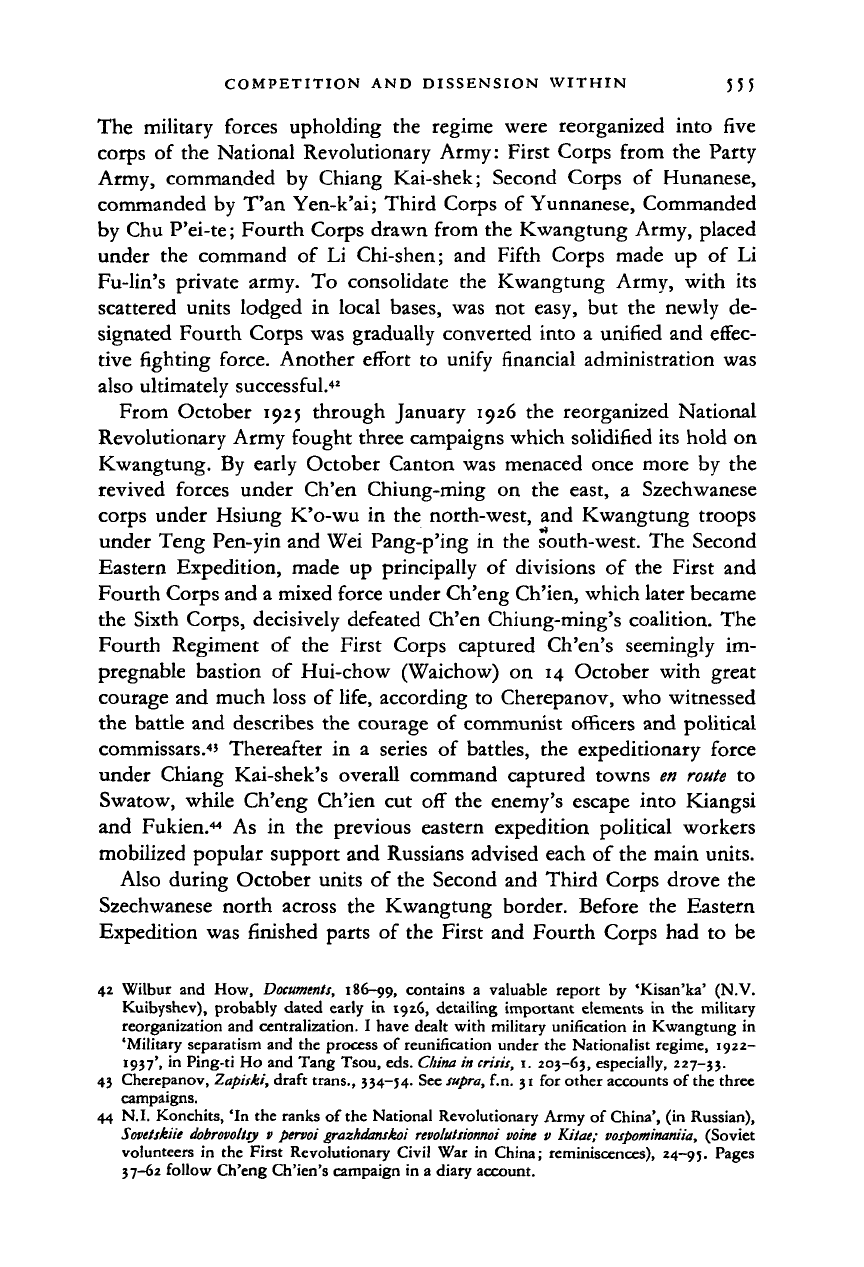
COMPETITION AND DISSENSION WITHIN 5JJ
The military forces upholding the regime were reorganized into five
corps of the National Revolutionary Army: First Corps from the Party
Army, commanded by Chiang Kai-shek; Second Corps of Hunanese,
commanded by T'an Yen-k'ai; Third Corps of Yunnanese, Commanded
by Chu P'ei-te; Fourth Corps drawn from the Kwangtung Army, placed
under the command of Li Chi-shen; and Fifth Corps made up of Li
Fu-lin's private army. To consolidate the Kwangtung Army, with its
scattered units lodged in local bases, was not easy, but the newly de-
signated Fourth Corps was gradually converted into a unified and effec-
tive fighting force. Another effort to unify financial administration was
also ultimately successful.
42
From October 1925 through January 1926 the reorganized National
Revolutionary Army fought three campaigns which solidified its hold on
Kwangtung. By early October Canton was menaced once more by the
revived forces under Ch'en Chiung-ming on the east, a Szechwanese
corps under Hsiung K'o-wu in the north-west, and Kwangtung troops
under Teng Pen-yin and Wei Pang-p'ing in the south-west. The Second
Eastern Expedition, made up principally of divisions of the First and
Fourth Corps and a mixed force under Ch'eng Ch'ien, which later became
the Sixth Corps, decisively defeated Ch'en Chiung-ming's coalition. The
Fourth Regiment of the First Corps captured Ch'en's seemingly im-
pregnable bastion of Hui-chow (Waichow) on 14 October with great
courage and much loss of life, according to Cherepanov, who witnessed
the battle and describes the courage of communist officers and political
commissars.
4
' Thereafter in a series of battles, the expeditionary force
under Chiang Kai-shek's overall command captured towns en route to
Swatow, while Ch'eng Ch'ien cut off the enemy's escape into Kiangsi
and Fukien.
44
As in the previous eastern expedition political workers
mobilized popular support and Russians advised each of the main units.
Also during October units of the Second and Third Corps drove the
Szechwanese north across the Kwangtung border. Before the Eastern
Expedition was finished parts of the First and Fourth Corps had to be
42 Wilbur and How, Documents, 186-99, contains a valuable report by 'Kisan'ka' (N.V.
Kuibyshev), probably dated early in 1926, detailing important elements in the military
reorganization and centralization. I have dealt with military unification in Kwangtung in
'Military separatism and the process of reunification under the Nationalist regime, 1922-
1937', in Ping-ti Ho and Tang Tsou, eds.
China
in
crisis,
1. 203-63, especially, 227-33.
43 Cherepanov, Zapiski, draft trans., 334-54. See
supra,
f.n. 31 for other accounts of the three
campaigns.
44 N.I. Konchits, 'In the ranks of the National Revolutionary Army of China', (in Russian),
Swetskiie
dobrovoltsy
v pervoi
grazhdanskoi revolutsionnoi voine
v Kitae;
vospominaniia,
(Soviet
volunteers in the First Revolutionary Civil War in China; reminiscences), 24-95. Pages
37-62 follow Ch'eng Ch'ien's campaign in a diary account.
Cambridge Histories Online © Cambridge University Press, 2008
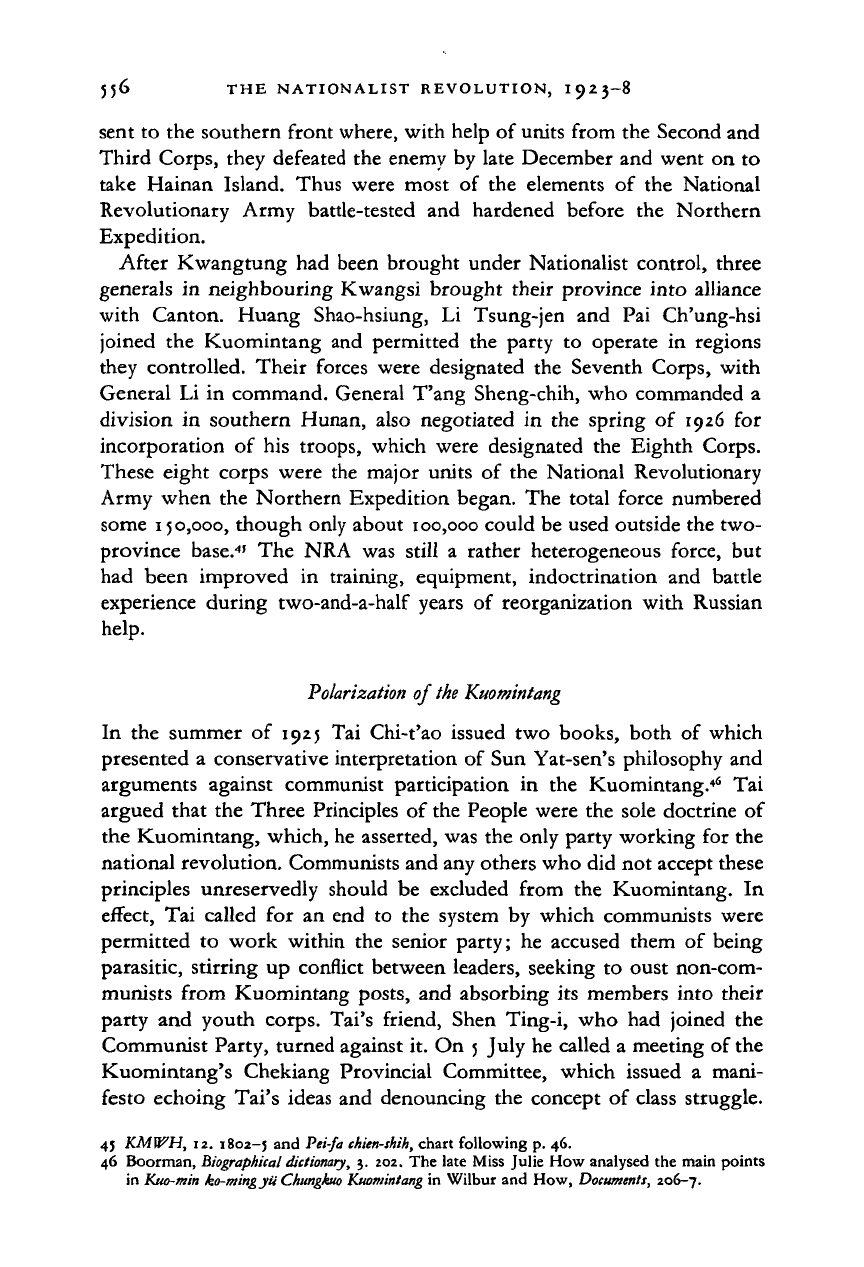
556 THE NATIONALIST REVOLUTION, I 9 2 3-8
sent to the southern front where, with help of units from the Second and
Third Corps, they defeated the enemy by late December and went on to
take Hainan Island. Thus were most of the elements of the National
Revolutionary Army battle-tested and hardened before the Northern
Expedition.
After Kwangtung had been brought under Nationalist control, three
generals in neighbouring Kwangsi brought their province into alliance
with Canton. Huang Shao-hsiung, Li Tsung-jen and Pai Ch'ung-hsi
joined the Kuomintang and permitted the party to operate in regions
they controlled. Their forces were designated the Seventh Corps, with
General Li in command. General T'ang Sheng-chih, who commanded a
division in southern Hunan, also negotiated in the spring of 1926 for
incorporation of his troops, which were designated the Eighth Corps.
These eight corps were the major units of the National Revolutionary
Army when the Northern Expedition began. The total force numbered
some 150,000, though only about 100,000 could be used outside the two-
province base.
45
The NRA was still a rather heterogeneous force, but
had been improved in training, equipment, indoctrination and battle
experience during two-and-a-half years of reorganization with Russian
help.
Polarization of
the
Kuomintang
In the summer of 1925 Tai Chi-t'ao issued two books, both of which
presented a conservative interpretation of Sun Yat-sen's philosophy and
arguments against communist participation in the Kuomintang.
46
Tai
argued that the Three Principles of the People were the sole doctrine of
the Kuomintang, which, he asserted, was the only party working for the
national revolution. Communists and any others who did not accept these
principles unreservedly should be excluded from the Kuomintang. In
effect, Tai called for an end to the system by which communists were
permitted to work within the senior party; he accused them of being
parasitic, stirring up conflict between leaders, seeking to oust non-com-
munists from Kuomintang posts, and absorbing its members into their
party and youth corps. Tai's friend, Shen Ting-i, who had joined the
Communist Party, turned against it. On
5
July he called a meeting of the
Kuomintang's Chekiang Provincial Committee, which issued a mani-
festo echoing Tai's ideas and denouncing the concept of class struggle.
45
KMWH,
12. 1802-5 and Pei-fa
chien-shih,
chart following p. 46.
46 Boorman,
Biographical
dictionary,
3. 202. The late Miss Julie How analysed the main points
in Kuo-min ko-mingyii
Chungkuo Kuomintang
in Wilbur and How, Documents, 206-7.
Cambridge Histories Online © Cambridge University Press, 2008

COMPETITION AND DISSENSION WITHIN 557
The Shanghai Executive Headquarters printed this document and sent
it to all Kuomintang offices under its jurisdiction; it also issued an instruc-
tion forbidding Kuomintang members to advocate class struggle.
47
The Communist Party responded to this challenge. Ch'en Tu-hsiu, the
party's leader, published an open letter to Tai, dated 30 August, in which
he defended communist motives in joining the Kuomintang and warned
that Tai's writings were being used by reactionaries as propaganda.
48
The Central Committee held an enlarged plenum in Peking in October
which passed a resolution on relations between the Communist Party and
the Kuomintang. The resolution attacked Tai and others like him as the
principal enemies and re-emphasized the policy of alliance with the left
wing of the Kuomintang against the right. The resolution attempted to
set standards for classifying members of the two factions but expressed
doubts as to the real strength of the left.
49
A group of Kuomintang veterans met in the Western Hills near Peking
in November 1925 in what they called a plenum of the Central Executive
Committee of the Kuomintang. Actually the party was so riven by con-
troversy over the radical course being followed in Canton that neither the
Peking group nor the leaders in Canton could muster a quorum of the
CEC.
Nevertheless, the 'Fourth CEC Plenum' decided to expel com-
munists from the Kuomintang and declared that national revolution and
class revolution could not go forward together. The group declared
Borodin's relationship with the party terminated, dissolved the Political
Council, which had no constitutional basis, and suspended Wang Ching-
wei from party membership for six months. These measures had no bind-
ing effect. In retaliation the leaders in Canton used the CEC name to issue
a manifesto denouncing Tsou Lu and Hsieh Ch'ih for their leadership of
the Western Hills group, and in an open letter, Chiang Kai-shek defended
Wang, Borodin and the Chinese communists. The Western Hills faction
set up headquarters in Shanghai, seized the local membership records,
took over the Min-kuo jih-pao as its mouthpiece, and planned to call the
Second National Congress of the Kuomintang.'
0
The leaders in Canton succeeded, however, in assembling their Second
National Congress first. It met in Canton from 4 to 19 January 1926, with
253 voting delegates, and heard a variety of reports on party work, indud-
47 TJK, 411-12, based on the documents preserved in Kuomintang Archives.
48 Ch'en Tu-hsiu, 'Letter to Tai Chi-t'ao', HTCP, 130 (18 September 1925) 1196-7.
49 Wilbur and How,
Documents,
234-7.
50 'Important documents of the Western Hills Conference expelling communists from the
Kuomintang, November 1925', Kuo-aen
chou-pao,
4. 14 (17 April 1927) 14-16; Tsou Lu,
Hui-ku-lu (Reminiscences), 1. 180-9; Tai Chi-t'ao, Tai Chi-t'ao
hsien-sheng wen-ts'un
(Col-
lected writings of Mr Tai Chi-t'ao), edited by Ch'en T'ien-hsi, 3. 975-8 and 985; TJK,
413-34 (based on Kuomintang Archives); Wilbur and How,
Documents,
209-12.
Cambridge Histories Online © Cambridge University Press, 2008
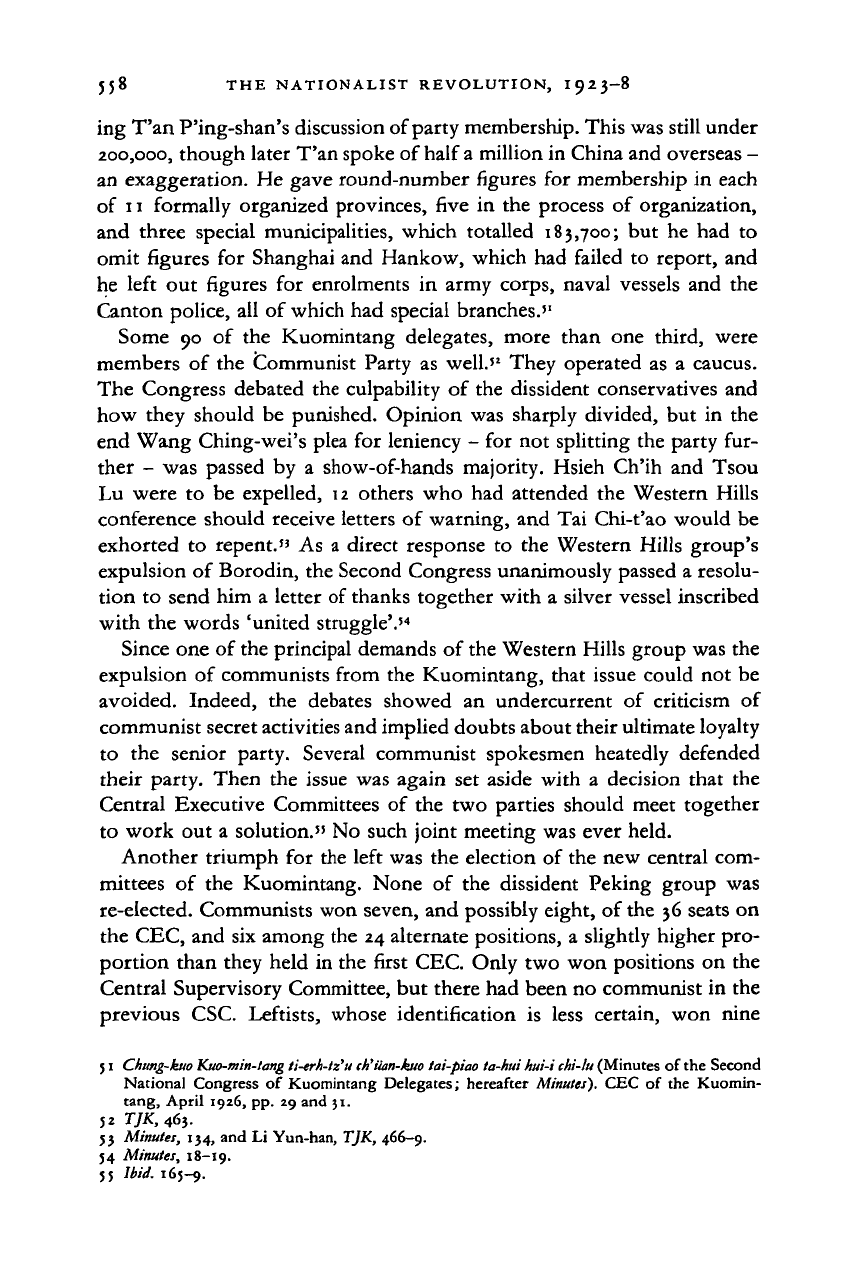
558 THE NATIONALIST REVOLUTION, I923-8
ing T'an P'ing-shan's discussion of party membership. This was still under
200,000, though later T'an spoke of half
a
million in China and overseas -
an exaggeration. He gave round-number figures for membership in each
of 11 formally organized provinces, five in the process of organization,
and three special municipalities, which totalled 183,700; but he had to
omit figures for Shanghai and Hankow, which had failed to report, and
he left out figures for enrolments in army corps, naval vessels and the
Canton police, all of which had special branches.'
1
Some 90 of the Kuomintang delegates, more than one third, were
members of the Communist Party as well.
52
They operated as a caucus.
The Congress debated the culpability of the dissident conservatives and
how they should be punished. Opinion was sharply divided, but in the
end Wang Ching-wei's plea for leniency - for not splitting the party fur-
ther - was passed by a show-of-hands majority. Hsieh Ch'ih and Tsou
Lu were to be expelled, 12 others who had attended the Western Hills
conference should receive letters of warning, and Tai Chi-t'ao would be
exhorted to repent." As a direct response to the Western Hills group's
expulsion of Borodin, the Second Congress unanimously passed a resolu-
tion to send him a letter of thanks together with a silver vessel inscribed
with the words 'united struggle'.
54
Since one of the principal demands of the Western Hills group was the
expulsion of communists from the Kuomintang, that issue could not be
avoided. Indeed, the debates showed an undercurrent of criticism of
communist secret activities and implied doubts about their ultimate loyalty
to the senior party. Several communist spokesmen heatedly defended
their party. Then the issue was again set aside with a decision that the
Central Executive Committees of the two parties should meet together
to work out a solution.
55
No such joint meeting was ever held.
Another triumph for the left was the election of the new central com-
mittees of the Kuomintang. None of the dissident Peking group was
re-elected. Communists won seven, and possibly eight, of the 36 seats on
the CEC, and six among the 24 alternate positions, a slightly higher pro-
portion than they held in the first CEC. Only two won positions on the
Central Supervisory Committee, but there had been no communist in the
previous CSC. Leftists, whose identification is less certain, won nine
51
Chung-kuo Kuo-min-tang
ti-erh-tz'u
ch'iian-kuo
tai-piao
ta-hui hui-i chi-lu
(Minutes of the Second
National Congress of Kuomintang Delegates; hereafter Minutes). CEC of the Kuomin-
tang, April 1926, pp. 29 and 31.
52 TJK, 463.
53 Minutes, 134, and Li Yun-han, TJK, 466-9.
54 Minutes, 18-19.
55
Ibid.
165-9.
Cambridge Histories Online © Cambridge University Press, 2008
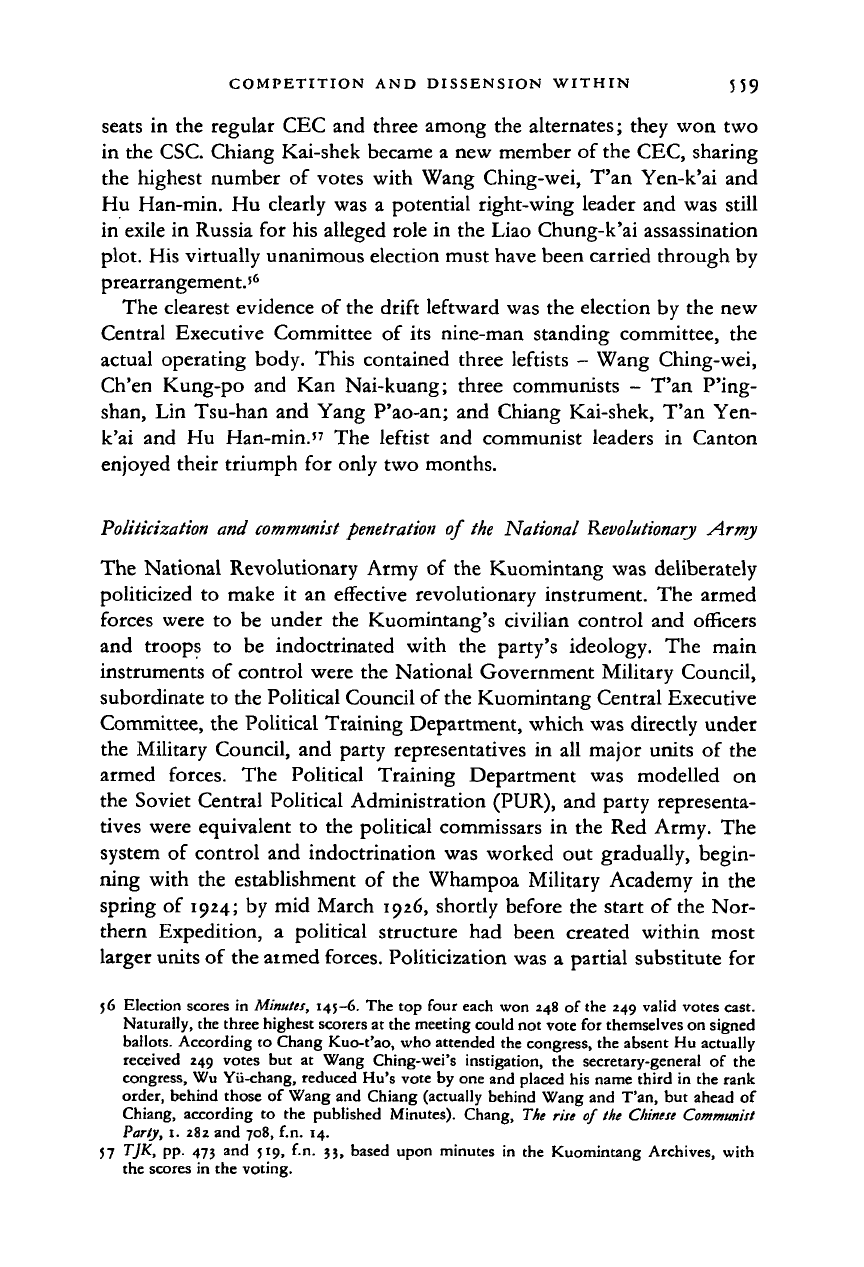
COMPETITION AND DISSENSION WITHIN 559
seats in the regular CEC and three among the alternates; they won two
in the CSC. Chiang Kai-shek became a new member of the CEC, sharing
the highest number of votes with Wang Ching-wei, T'an Yen-k'ai and
Hu Han-min. Hu clearly was a potential right-wing leader and was still
in exile in Russia for his alleged role in the Liao Chung-k'ai assassination
plot. His virtually unanimous election must have been carried through by
prearrangement.'
6
The clearest evidence of the drift leftward was the election by the new
Central Executive Committee of its nine-man standing committee, the
actual operating body. This contained three leftists - Wang Ching-wei,
Ch'en Kung-po and Kan Nai-kuang; three communists - T'an P'ing-
shan, Lin Tsu-han and Yang P'ao-an; and Chiang Kai-shek, T'an Yen-
k'ai and Hu Han-min.'
7
The leftist and communist leaders in Canton
enjoyed their triumph for only two months.
Politicization and communist penetration of the National Revolutionary Army
The National Revolutionary Army of the Kuomintang was deliberately
politicized to make it an effective revolutionary instrument. The armed
forces were to be under the Kuomintang's civilian control and officers
and troops to be indoctrinated with the party's ideology. The main
instruments of control were the National Government Military Council,
subordinate to the Political Council of the Kuomintang Central Executive
Committee, the Political Training Department, which was directly under
the Military Council, and party representatives in all major units of the
armed forces. The Political Training Department was modelled on
the Soviet Central Political Administration (PUR), and party representa-
tives were equivalent to the political commissars in the Red Army. The
system of control and indoctrination was worked out gradually, begin-
ning with the establishment of the Whampoa Military Academy in the
spring of 1924; by mid March 1926, shortly before the start of the Nor-
thern Expedition, a political structure had been created within most
larger units of the aimed forces. Politicization was a partial substitute for
56 Election scores in Minutes, 145-6. The top four each won 248 of the 249 valid votes cast.
Naturally, the three highest scorers at the meeting could not vote for themselves on signed
ballots. According to Chang Kuo-t'ao, who attended the congress, the absent Hu actually
received 249 votes but at Wang Ching-wei's instigation, the secretary-general of the
congress, Wu Yu-chang, reduced Hu's vote by one and placed his name third in the rank
order, behind those of Wang and Chiang (actually behind Wang and T'an, but ahead of
Chiang, according to the published Minutes). Chang, The rise of the
Chinese
Communist
Party, 1. 282 and 708, f.n. 14.
57 TJK, pp. 47} and 519, f.n. 33, based upon minutes in the Kuomintang Archives, with
the scores in the voting.
Cambridge Histories Online © Cambridge University Press, 2008
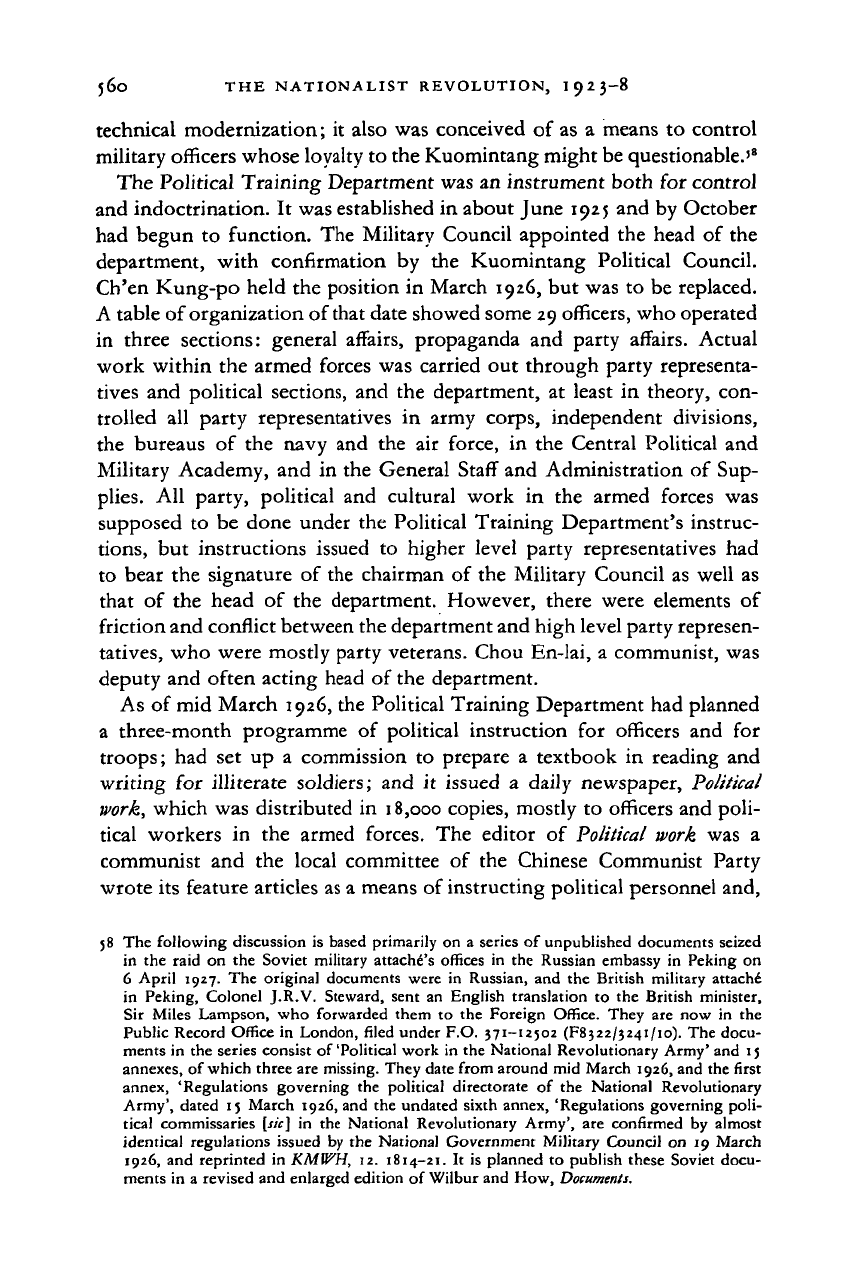
560 THE NATIONALIST REVOLUTION, I923-8
technical modernization;
it
also was conceived
of
as
a
means
to
control
military officers whose loyalty to the Kuomintang might be questionable.'
8
The Political Training Department was
an
instrument both
for
control
and indoctrination.
It
was established in about June 1925 and
by
October
had begun
to
function.
The
Military Council appointed
the
head
of the
department, with confirmation
by the
Kuomintang Political Council.
Ch'en Kung-po held
the
position
in
March 1926,
but
was
to be
replaced.
A table of organization of that date showed some 29 officers, who operated
in three sections: general affairs, propaganda
and
party affairs. Actual
work within
the
armed forces was carried
out
through party representa-
tives
and
political sections,
and the
department,
at
least
in
theory,
con-
trolled
all
party representatives
in
army corps, independent divisions,
the bureaus
of the
navy
and the air
force,
in the
Central Political
and
Military Academy,
and in
the General Staff and Administration
of
Sup-
plies.
All
party, political
and
cultural work
in the
armed forces
was
supposed
to be
done under
the
Political Training Department's instruc-
tions,
but
instructions issued
to
higher level party representatives
had
to bear
the
signature
of
the chairman
of
the Military Council
as
well
as
that
of the
head
of the
department. However, there were elements
of
friction and conflict between the department and high level party represen-
tatives, who were mostly party veterans. Chou En-lai,
a
communist,
was
deputy and often acting head
of
the department.
As
of
mid March 1926, the Political Training Department had planned
a three-month programme
of
political instruction
for
officers
and for
troops;
had set up a
commission
to
prepare
a
textbook
in
reading
and
writing
for
illiterate soldiers;
and it
issued
a
daily newspaper, Political
work, which was distributed
in
18,000 copies, mostly
to
officers and poli-
tical workers
in the
armed forces.
The
editor
of
Political work
was a
communist
and the
local committee
of the
Chinese Communist Party
wrote its feature articles as
a
means
of
instructing political personnel and,
58 The following discussion
is
based primarily
on a
series
of
unpublished documents seized
in
the
raid
on the
Soviet military attache's offices
in the
Russian embassy
in
Peking
on
6 April 1927.
The
original documents were
in
Russian,
and the
British military attache
in Peking, Colonel J.R.V. Steward, sent
an
English translation
to the
British minister,
Sir Miles Lampson,
who
forwarded them
to the
Foreign Office. They
are now in the
Public Record Office
in
London, filed under F.O. 371-12502 (F8322/3241/10). The docu-
ments
in
the series consist
of
'Political work
in
the National Revolutionary Army' and
15
annexes,
of
which three are missing. They date from around mid March 1926, and the first
annex, 'Regulations governing
the
political directorate
of the
National Revolutionary
Army', dated
15
March 1926, and the undated sixth annex, 'Regulations governing poli-
tical commissaries
[sic]
in the
National Revolutionary Army',
are
confirmed
by
almost
identical regulations issued by
the
National Government Military Council
on
19 March
1926,
and
reprinted
in
KM1VH,
12.
1814-21.
It is
planned
to
publish these Soviet docu-
ments
in a
revised and enlarged edition
of
Wilbur and How,
Documents.
Cambridge Histories Online © Cambridge University Press, 2008
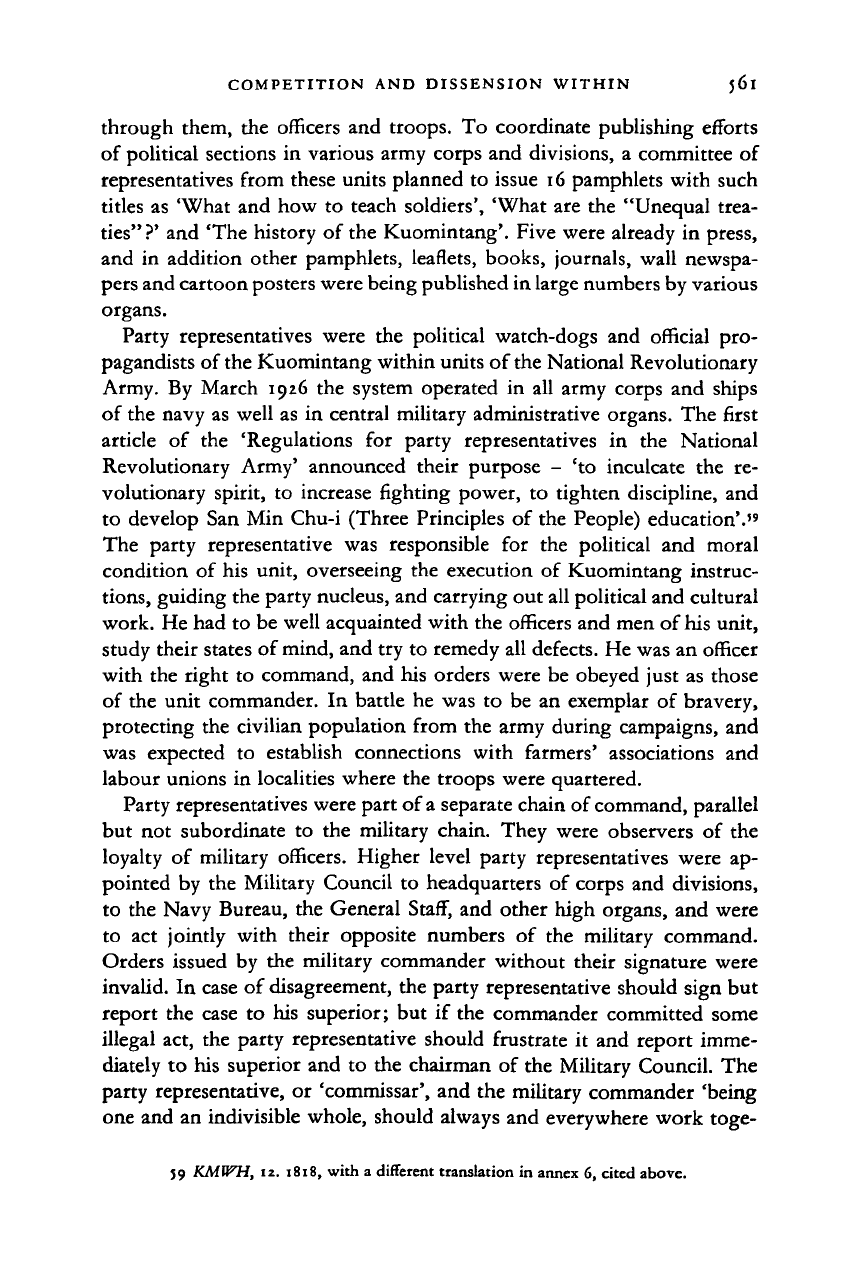
COMPETITION AND DISSENSION WITHIN 561
through them,
the
officers
and
troops.
To
coordinate publishing efforts
of political sections
in
various army corps
and
divisions,
a
committee
of
representatives from these units planned
to
issue 16 pamphlets with such
titles
as
'What
and how to
teach soldiers', 'What
are the
"Unequal trea-
ties"
?'
and
'The history
of
the Kuomintang'. Five were already
in
press,
and
in
addition other pamphlets, leaflets, books, journals, wall newspa-
pers and cartoon posters were being published in large numbers by various
organs.
Party representatives were
the
political watch-dogs
and
official
pro-
pagandists
of
the Kuomintang within units
of
the National Revolutionary
Army.
By
March 1926
the
system operated
in all
army corps
and
ships
of the navy
as
well
as in
central military administrative organs.
The
first
article
of the
'Regulations
for
party representatives
in the
National
Revolutionary Army' announced their purpose
- 'to
inculcate
the re-
volutionary spirit,
to
increase fighting power,
to
tighten discipline,
and
to develop
San Min
Chu-i (Three Principles
of
the People) education'."
The party representative
was
responsible
for the
political
and
moral
condition
of
his unit, overseeing
the
execution
of
Kuomintang instruc-
tions,
guiding the party nucleus, and carrying out all political and cultural
work. He had
to be
well acquainted with
the
officers
and
men
of
his unit,
study their states
of
mind, and
try to
remedy all defects. He was
an
officer
with
the
right
to
command,
and his
orders were
be
obeyed just
as
those
of
the
unit commander.
In
battle
he was to be an
exemplar
of
bravery,
protecting
the
civilian population from
the
army during campaigns,
and
was expected
to
establish connections with farmers' associations
and
labour unions
in
localities where
the
troops were quartered.
Party representatives were part
of
a
separate chain
of
command, parallel
but
not
subordinate
to the
military chain. They were observers
of the
loyalty
of
military officers. Higher level party representatives were
ap-
pointed
by the
Military Council
to
headquarters
of
corps
and
divisions,
to
the
Navy Bureau,
the
General
Staff,
and
other high organs,
and
were
to
act
jointly with their opposite numbers
of the
military command.
Orders issued
by the
military commander without their signature were
invalid.
In
case
of
disagreement, the party representative should sign
but
report
the
case
to his
superior;
but if
the commander committed some
illegal
act, the
party representative should frustrate
it and
report imme-
diately
to his
superior
and to the
chairman
of
the Military Council.
The
party representative,
or
'commissar',
and the
military commander 'being
one
and an
indivisible whole, should always
and
everywhere work toge-
59
KMWH,
12.
1818, with
a
different translation
in
annex
6,
cited above.
Cambridge Histories Online © Cambridge University Press, 2008
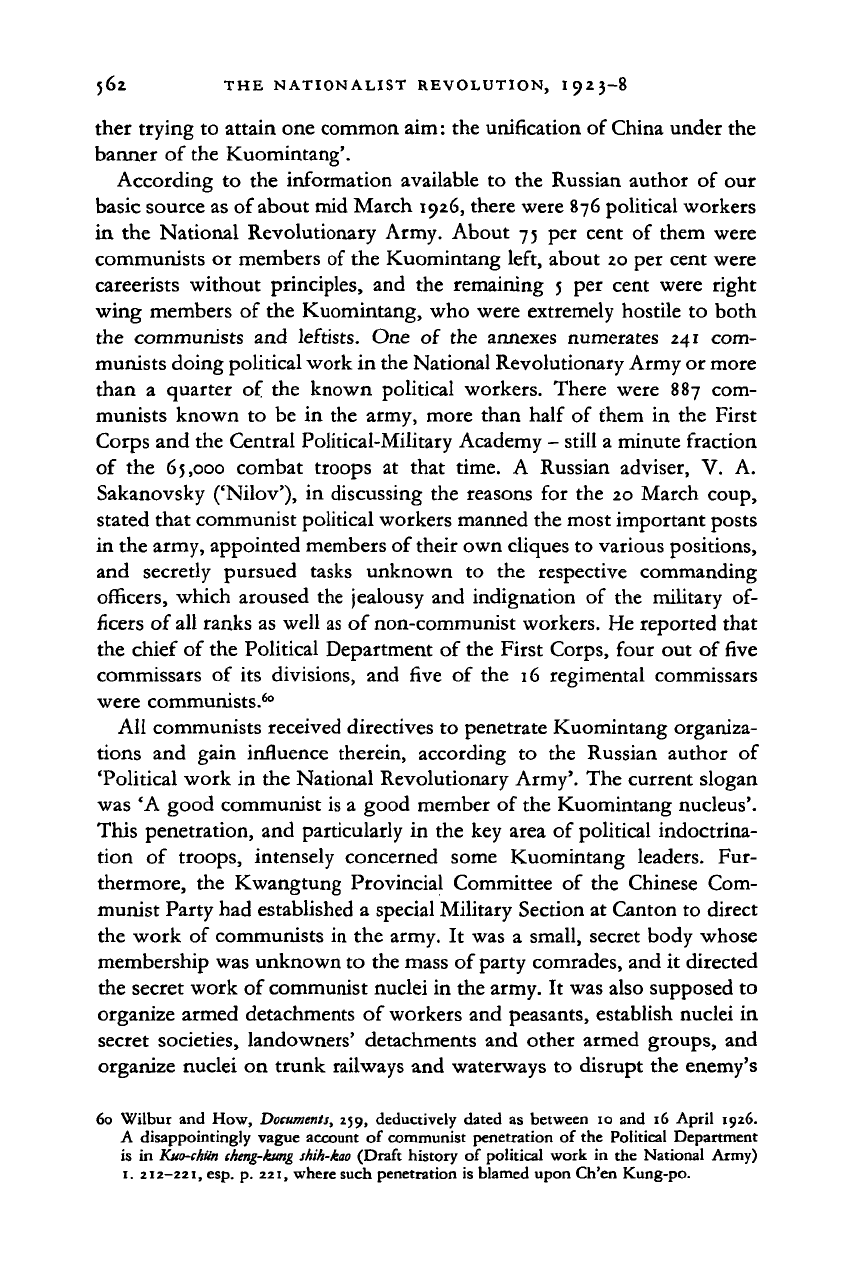
562 THE NATIONALIST REVOLUTION, I 923-8
ther trying to attain one common aim: the unification of China under the
banner of the Kuomintang'.
According to the information available to the Russian author of our
basic source as of about mid March 1926, there were 876 political workers
in the National Revolutionary Army. About 75 per cent of them were
communists or members of the Kuomintang left, about 20 per cent were
careerists without principles, and the remaining 5 per cent were right
wing members of the Kuomintang, who were extremely hostile to both
the communists and leftists. One of the annexes numerates 241 com-
munists doing political work in the National Revolutionary Army or more
than a quarter of the known political workers. There were 887 com-
munists known to be in the army, more than half of them in the First
Corps and the Central Political-Military Academy - still a minute fraction
of the 65,000 combat troops at that time. A Russian adviser, V. A.
Sakanovsky ('Nilov'), in discussing the reasons for the 20 March coup,
stated that communist political workers manned the most important posts
in the army, appointed members of their own cliques to various positions,
and secretly pursued tasks unknown to the respective commanding
officers, which aroused the jealousy and indignation of the military of-
ficers of all ranks as well as of non-communist workers. He reported that
the chief of the Political Department of the First Corps, four out of five
commissars of its divisions, and five of the 16 regimental commissars
were communists.
60
All communists received directives to penetrate Kuomintang organiza-
tions and gain influence therein, according to the Russian author of
'Political work in the National Revolutionary Army'. The current slogan
was 'A good communist is a good member of the Kuomintang nucleus'.
This penetration, and particularly in the key area of political indoctrina-
tion of troops, intensely concerned some Kuomintang leaders. Fur-
thermore, the Kwangtung Provincial Committee of the Chinese Com-
munist Party had established a special Military Section at Canton to direct
the work of communists in the army. It was a small, secret body whose
membership was unknown to the mass of party comrades, and it directed
the secret work of communist nuclei in the army. It was also supposed to
organize armed detachments of workers and peasants, establish nuclei in
secret societies, landowners' detachments and other armed groups, and
organize nuclei on trunk railways and waterways to disrupt the enemy's
60 Wilbur and How, Documents, 259, deductively dated as between 10 and 16 April 1926.
A disappointingly vague account of communist penetration of the Political Department
is in
Kuo-chim cheng-kung shih-kao
(Draft history of political work in the National Army)
1.
212-221, esp. p. 221, where such penetration is blamed upon Ch'en Kung-po.
Cambridge Histories Online © Cambridge University Press, 2008
